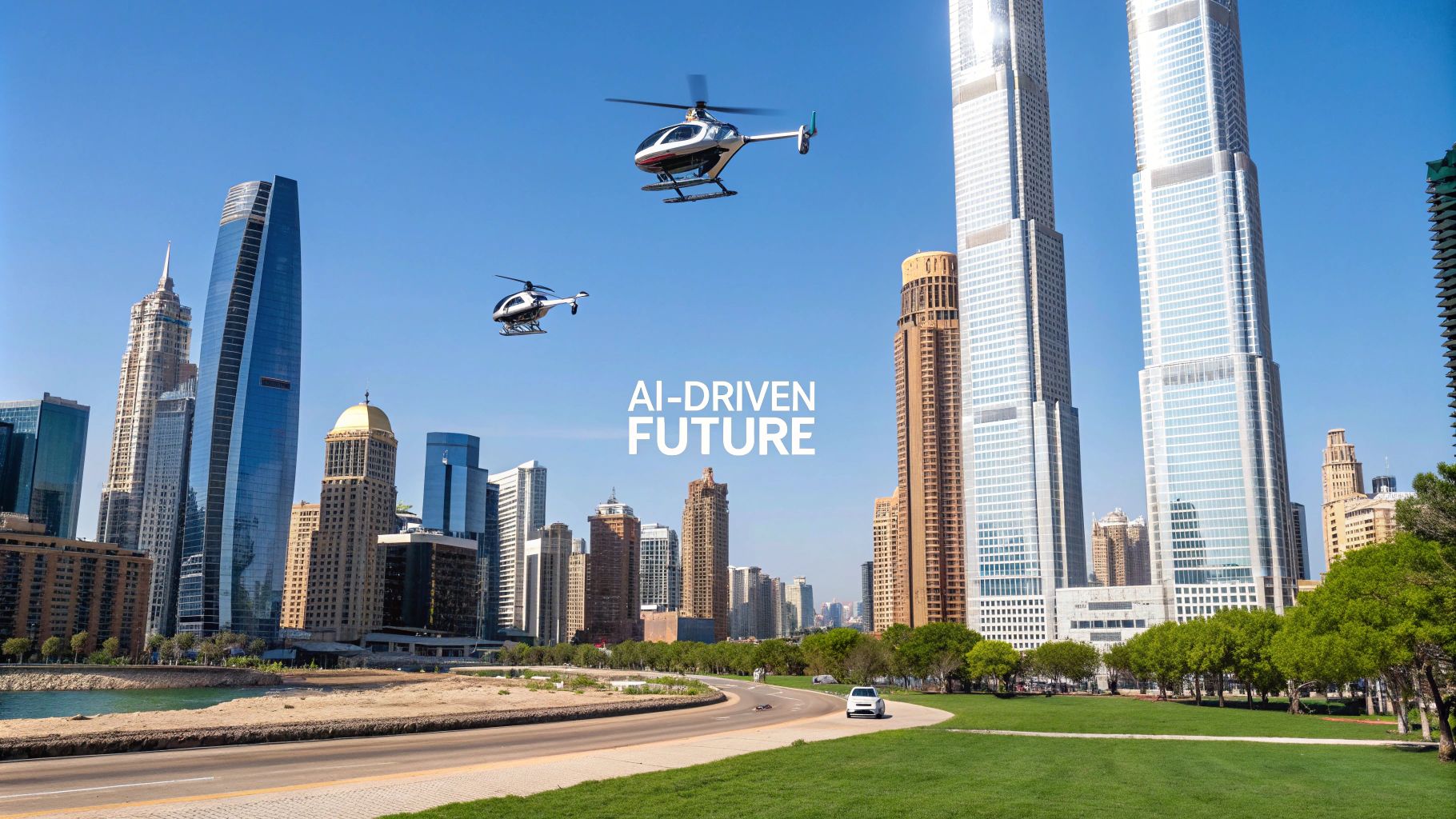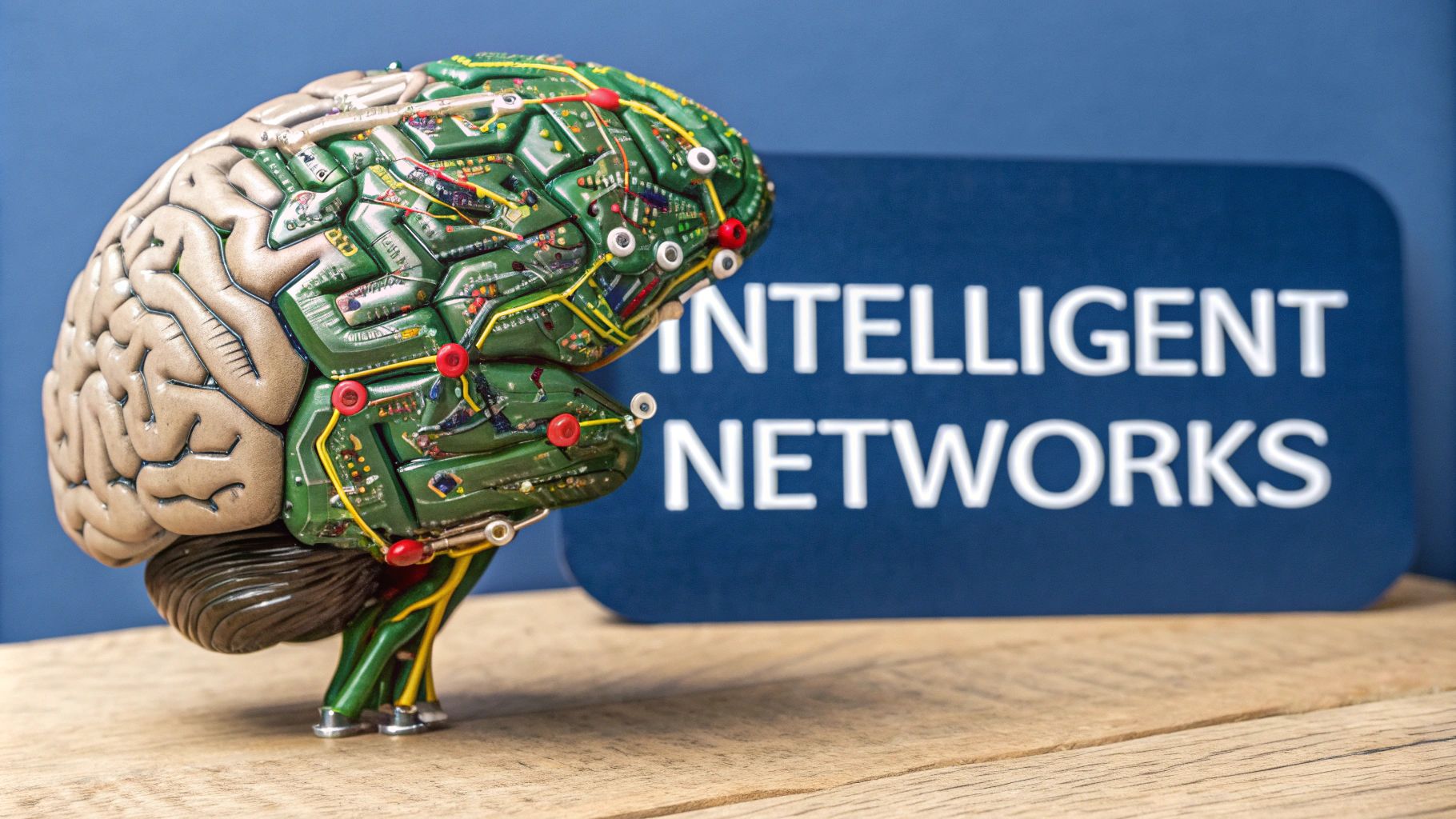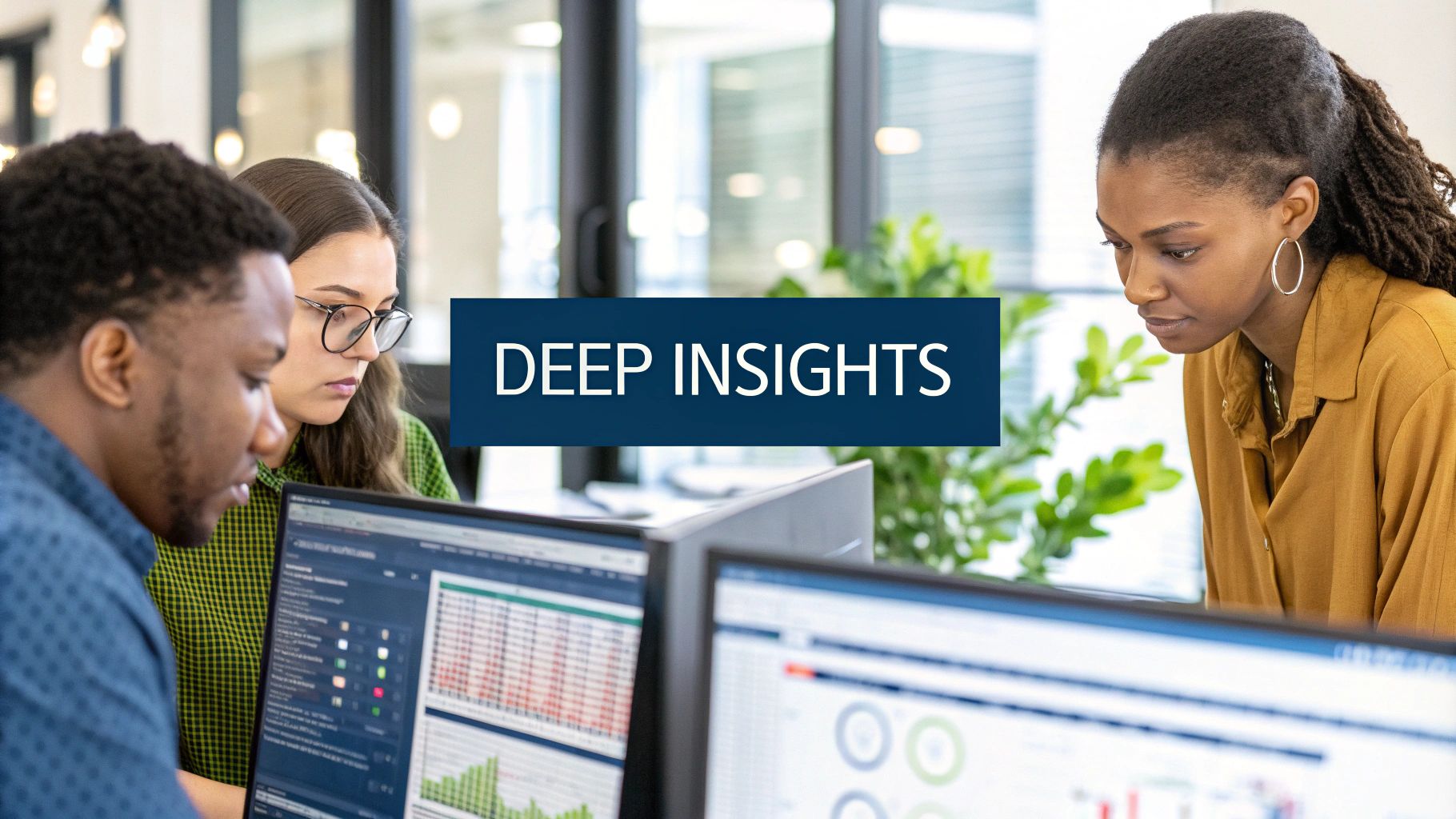The Future of Artificial Intelligence: What’s Really Transforming Business and Society
Understanding AI's True Market Trajectory
AI is becoming deeply woven into the fabric of business and society. The numbers tell a clear story – with a projected growth rate of 28.46% year over year, AI is moving from an experimental technology to an essential business tool. This rapid adoption reflects how AI is already delivering real results across industries, from healthcare to manufacturing.
Deconstructing the AI Market Growth
The projected $826.70 billion market value by 2030 stems from practical applications gaining traction today. In healthcare, doctors are using AI to spot diseases earlier and develop more effective treatments. Banks have integrated AI to catch fraud and assess lending risks more accurately. These real-world use cases, multiplied across sectors, explain why the market is expanding so quickly. Companies aren't just testing AI – they're putting it to work solving concrete business problems.
Beyond the Buzz: Real-World Applications Driving Growth
The most compelling evidence of AI's impact comes from its practical applications. Take generative AI, which is set to create $1.3 trillion in value by 2032. Companies are already using tools like Jasper.ai to write marketing content faster and better. Product designers use AI to quickly generate and test new concepts. Scientists apply it to accelerate research and discovery. These aren't future possibilities – they're happening now, changing how work gets done.
Navigating the Challenges and Opportunities of AI's Growth
As AI becomes more powerful, companies face important choices about how to use it responsibly. The technology is moving quickly, requiring careful thought about ethics, bias, and the impact on jobs. But organizations that find the right balance – using AI to improve efficiency while maintaining human oversight – can gain significant advantages. Success requires more than just buying AI tools. It means developing clear strategies for using AI effectively while addressing valid concerns about its impact. Companies that get this balance right will be best positioned as AI continues to reshape business and society.
The Reality of Generative AI's Impact
The numbers tell a clear story about generative AI. This technology is set to create $1.3 trillion in value by 2032 by doing something unprecedented – creating entirely new content from scratch. Unlike traditional AI that simply analyzes existing data, generative AI can produce original text, images, code, music and video. This capability is reshaping how work gets done across industries, from creative fields to technical domains.
Real-World Applications: Beyond the Buzzwords
What matters most is how generative AI solves real business problems. Take content creation for example – tools like Jasper.ai help marketing teams produce high-quality copy, blog posts and social media content in a fraction of the usual time. A small team can now match the output of a much larger agency. The impact extends to product design too, where AI assists designers in rapidly testing and refining countless design options. This accelerates development cycles while encouraging creative exploration of new possibilities.
Transforming Industries: A Glimpse into the Future
The effects ripple far beyond individual tasks. In pharmaceuticals, generative AI helps design new drug molecules, potentially reducing discovery timelines by years. Financial firms use it to create synthetic data for training more accurate risk models that lead to smarter investment choices. Manufacturing companies apply the technology to optimize production, personalize products, and even develop materials with specific desired properties. These examples show how generative AI opens up entirely new approaches to longstanding challenges.
Implementing Generative AI: Challenges and Solutions
Making generative AI work effectively requires careful planning. A major concern is ensuring ethical use – AI models can unintentionally reflect biases present in their training data, leading to unfair outcomes. This makes thorough testing and monitoring essential. Companies also need to help their teams build new skills to work effectively with AI tools. This includes learning to evaluate AI-generated outputs, spot potential issues, and make good decisions based on the insights provided. While these challenges are significant, addressing them thoughtfully allows organizations to use AI to expand human capabilities and drive growth in new ways.
How AI Shapes the Economy
AI's influence on the global economy continues to grow, with projections showing it could add over $15.7 trillion in value. This massive shift goes beyond just new technology – it's changing how businesses create and capture value. Understanding these changes helps companies and individuals make better decisions about where to focus their efforts and investments.
Different Industries, Different Impact
AI's effects vary significantly across industries. Healthcare organizations are using AI-powered tools to improve diagnosis accuracy and patient care. Manufacturing companies have implemented predictive maintenance systems that spot potential equipment failures before they happen, reducing costly downtime. Meanwhile, sectors like education and government services are moving more slowly, taking time to figure out how AI fits their specific needs. This varied adoption rate means some industries are pulling ahead while others work to catch up.
Geographic Differences Matter
Not all regions benefit equally from AI advances. Areas with established tech communities and supportive government policies attract more AI investment and talent. Silicon Valley, for example, draws significant resources that help local companies develop their AI capabilities faster than competitors elsewhere. This creates gaps between regions that could grow larger if left unaddressed. Finding ways to spread AI's benefits more evenly across different areas remains an important challenge.
Changing How Business Works
Companies need to rethink their approach to stay competitive as AI becomes more central to business success. This means more than just buying new software – it requires new ways of working. Successful companies are building teams that know how to work with data, encouraging new ideas, and developing skills to use AI effectively. Those who stick to old methods risk falling behind as their competitors move forward.
Finding What Really Works
While AI offers many possibilities, it's essential to separate real opportunities from empty promises. Not every AI project will pay off, and some might even cause problems. Smart businesses start by understanding their specific challenges, then carefully evaluate which AI solutions actually help solve them. Look for areas where AI can improve operations, make customers happier, or create new income sources. Taking this practical approach helps avoid wasting resources on AI projects that don't deliver real value.
Reshaping the Future of Work
When we think about artificial intelligence, the real story isn't just about technology – it's about people. While concerns about job losses exist, research shows AI will likely create more jobs than it replaces, with projections of 133 million new roles by 2030. This shift brings real challenges but also opens up exciting possibilities for both workers and organizations.
The Evolving Landscape of Skills
To succeed as AI becomes more common in the workplace, we need to focus on developing new abilities. Companies are actively hiring data scientists, AI specialists, and robotics engineers. At the same time, distinctly human skills like critical thinking, creativity, and complex problem-solving are becoming more important than ever. This means we all need to keep learning and growing our skillsets. Success in this new environment requires both technical knowledge and the human touch.
Adapting to the AI-Powered Workplace
AI is changing how we work in fundamental ways. As routine tasks become automated, people can focus on work that requires creativity, empathy, and strategic thinking. For example, a marketing team might use AI to analyze data trends while focusing their human energy on crafting compelling campaign stories. The key is learning to work alongside AI tools effectively – understanding what they can and can't do, making sense of their insights, and using them to make better decisions.
Future-Proofing Your Career in the Age of AI
So what steps can you take to prepare for these changes? Start by developing skills that are uniquely human – things AI still struggles with, like building relationships or thinking outside the box. Make learning a regular habit. Online platforms like Coursera and Udacity offer courses in everything from machine learning to data analysis. Most importantly, stay flexible and keep an open mind. Being able to adapt quickly and learn new things will help you thrive as jobs continue to evolve.
Reimagining Industries and Roles
These changes are happening across every industry. In healthcare, doctors are using AI to spot diseases earlier and create better treatment plans. Factory workers team up with smart robots to make products more efficiently. Even creative fields are changing – writers and designers now use tools like Jasper.ai to spark new ideas and speed up their work. Each industry is finding its own way to blend human skills with AI capabilities. The key to staying ahead is paying attention to how your field is changing and actively preparing for what's next. After all, the future isn't about AI replacing humans – it's about finding the right balance where both can shine.
Following the Smart Money in AI
Money flows tell us a lot about where AI is headed. By watching where major investors and companies put their resources, we can spot the most promising developments in artificial intelligence, separating real progress from empty hype. Understanding these investment patterns gives us clear signals about which AI technologies will matter most.
Decoding AI Investment Trends
Smart investors focus on concrete results rather than trendy buzzwords. A perfect example is the AI chip market, which is set to reach $83.25 billion by 2027. This growth comes from real demand – as AI systems get more complex, they need specialized hardware to handle intense processing tasks. Take generative AI, which creates new content like images and text. These systems need extremely powerful chips to work well. Similarly, AI applications in healthcare and finance require custom-built chips for their specific needs, pushing the market forward.
The Rise of Specialized AI Hardware
Regular computer processors just aren't enough anymore for advanced AI systems. As these models grow more sophisticated, they need hardware built specifically for AI tasks. This shift means companies working on specialized AI chips will likely shape the field's future. Their work will also affect how developers create AI software and applications.
Spotting Genuine Opportunities vs. Hype
While AI offers many promising opportunities, it's crucial to tell the difference between real potential and overblown claims. Here's a practical way to evaluate AI investments:
- Real-World Applications: Does it solve actual problems that people and businesses face?
- Scalability: Can it grow to serve more users without breaking down?
- Competitive Landscape: What makes it stand out from similar solutions?
- Ethical Considerations: How does it handle issues like bias and privacy?
Using these guidelines helps companies and investors put their money in the right places. This careful approach helps identify which technologies will truly matter in the long run, rather than chasing short-term trends that fizzle out.
Building Your AI Readiness Strategy
Success with AI requires more than just buying new tools – it needs thoughtful integration across your entire organization. Creating an effective AI strategy means preparing your teams, processes and infrastructure to work with AI in practical ways. Let's look at the key steps to get your organization ready.
Assessing Your Current AI Landscape
Before jumping into AI projects, take stock of where you are now. Start by evaluating three core areas:
- Data Infrastructure: Check if you have the right systems to collect, store and process data effectively. This includes having proper data storage, computing power, and clear data governance rules.
- Talent and Skills: Look at your team's AI capabilities. Do you need to hire data scientists and AI specialists? Can you train current employees? Map out the skills you'll need.
- Business Processes: Identify specific tasks and workflows where AI could add real value. Focus on areas that would benefit most from automation or improved decision-making.
Developing Key AI Capabilities
Getting good at AI takes work on multiple fronts. Here's what to focus on:
- Build Strong Infrastructure: Make sure you have enough computing power to run AI systems. Cloud platforms often work well since they can grow with your needs and help manage costs.
- Grow Your Team's Skills: Find and keep people who know AI. Help current employees learn new skills through training. Create clear career paths for AI roles.
- Welcome New Ideas: Give teams room to try new AI applications safely. Learn from what works and what doesn't. Share success stories across the organization.
Measuring and Tracking AI Progress
Building AI capabilities is an ongoing process that needs regular check-ins. Here's how to track your progress:
- Pick Clear Goals: Choose specific metrics that show if your AI projects are working. These should connect directly to your business goals.
- Watch the Numbers: Keep tabs on your progress using tools like DebugBar to check how well your AI-enabled applications perform. Fix problems quickly when you find them.
- Keep Improving: Stay flexible as AI technology changes. Update your approach based on what you learn and new developments in the field.
By understanding where you are, building the right capabilities, and tracking results carefully, you can create an AI strategy that works. Want help optimizing your web applications for AI? Visit DebugBar to learn more about our tools and resources.




Comments
Leave a comment